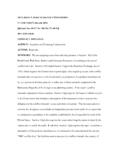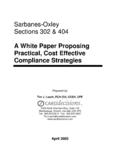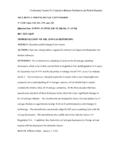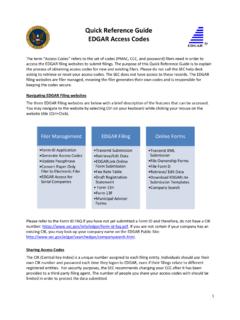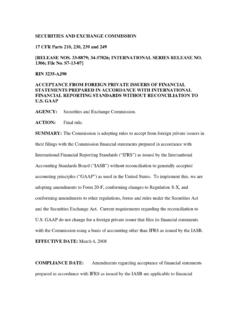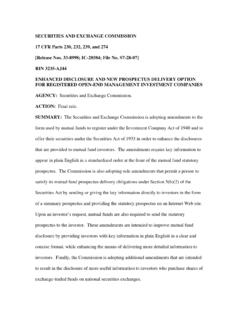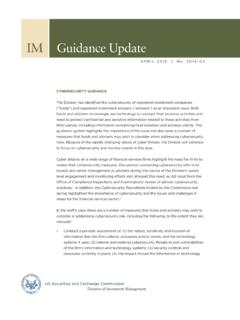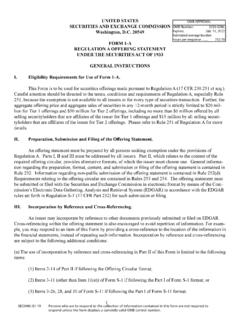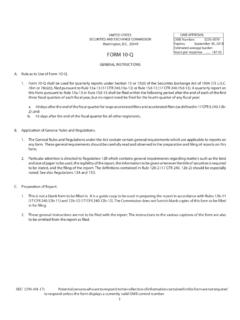Transcription of Edward S. Walczak
1 Case: 3:20-cv-00076-wmc Document #: 85 Filed: 02/04/22 Page 1 of 13. IN THE UNITED STATES DISTRICT COURT. FOR THE WESTERN DISTRICT OF WISCONSIN. UNITED STATES SECURITIES. AND EXCHANGE COMMISSION, Plaintiff, opinion AND ORDER. v. 20-cv-076-wmc Edward S. Walczak , Defendant. In this lawsuit, the Securities and Exchange Commission ( SEC ) is suing Edward Walczak for alleged violations of the Securities Exchange Act, 15 78a et seq., and Investment Advisers Act, 15 80b-1 et seq. The SEC now seeks partial summary judgment on three of its five claims under Sections 17(a)(1), 17(a)(2), and 17(a)(3) of the Securities Exchange Act and Section 206(4) of the Investment Advisors Act.
2 (Dkt. #24.). For the reasons discussed below, the court will grant that motion in part and deny it in part. UNDISPUTED FACTS. Defendant Edward S. Walczak was the Senior Portfolio Manager for the Catalyst Hedged Futures Strategy Fund ( Fund ), which traded in options on Standard and Poor's ( S&P ) 500 index futures contracts. (Pl.'s Reply to Pl.'s PFOFs (dkt. #41) 2, 40.) In that position, it is undisputed that Walczak acted as an investment fiduciary for the Fund. (Id. 3.) Futures contracts allow a party to buy or sell a particular investment vehicle at a specific price and time. (Id. 42.) An S&P futures contract is based on the underlying price of the S&P 500 index and changes with the value of that index.
3 (Id.. Case: 3:20-cv-00076-wmc Document #: 85 Filed: 02/04/22 Page 2 of 13. 44.) An options contract allows the party to buy or sell a futures contract at a fixed price on a specific date. (Id. 45.). The Fund mainly held call options between November 2016 and February 2017, during which the holder could buy the underlying futures contract. (Id. 47.) Walczak often discussed the Fund on calls with investment advisors ( House Calls ). (Id. 80.). During those calls, he often spoke about the Fund's risk management procedures, noting that he tried to keep the Fund under an 8% drawdown. (Id. 92.) Walczak also described how he used OptionVue, a sophisticated market modeling software, to model changes in the Fund and ward off the impact of potential drawdowns.
4 (Id.) Nevertheless, between January 31, 2017, and February 28, 2017, the Fund's price-per-share declined more than 18% as calculated using OptionVue software, contributing to significant losses for investors. (Id. 199.). opinion . In moving for summary judgement as the party who bears the burden of proof, plaintiff must lay out the elements of the claim, cite the facts [that] it believes satisfies these elements, and demonstrate why the record is so one-sided as to rule out the prospect of a finding in favor of the non-movant on the claim. Hotel 71 Mezz Lender LLC v. Nat'l Ret. Fund, 778 593, 601 (7th Cir. 2015); see also Reserve Supply Corp.
5 V. Owens-Corning Fiberglas Corp., 971 37, 42 (7th Cir. 1992) ( [B]ecause Owens-Corning and CertainTeed also have the burden at trial of establishing good faith, they must establish affirmatively the lack of sufficient evidence favoring the nonmoving party for a jury to return a verdict for that party.' (quoting Anderson v. Liberty Lobby, Inc., 477 242, 249- 2. Case: 3:20-cv-00076-wmc Document #: 85 Filed: 02/04/22 Page 3 of 13. 50 (1986))). If the movant has failed to make this initial showing, the court is obligated to deny the motion. Hotel 71, 778 at 601; see also Johnson v. Hix Wrecker Serv., Inc., 651 658, 662 (7th Cir.)
6 2011) ( A party opposing summary judgment does not have to rebut factual propositions on which the movant bears the burden of proof and that the movant has not properly supported in the first instance. ). This case presents much the same issues and conduct present in Commodity Futures Trading Commission v. Walczak , No. 20-cv-075-wmc ( Wis. Jan. 27, 2020) ( CFTC ). Indeed, given the significant overlap in the facts and claims in these cases, consolidation for trial would appear justified by interests in judicial economy. Regardless, this opinion will draw from the court's summary judgement decision in that case, CFTC, No.
7 20-cv- 075-wmc ( Wis. Nov. 22, 2021) (dkt. #67), while providing a more thorough analysis with respect to evidence and arguments not made by the CFTC. I. Existence of a Hard 8% Drawdown Limit In similar fashion as the CFTC, the SEC claims Walczak misrepresented that he mitigated the risk to the Fund by trading and rebalancing its holdings whenever OptionVue models predicted more than an 8% loss. While the SEC does a better job of marshalling facts and making more nuanced arguments in support of its claim in this regard than did the CFTC, the underlying evidence and summary judgment standard are essentially the same. As such, the court's ruling at summary judgment in the CFTC case is largely applicable here.
8 In particular, contrary to the SEC's claim, Walczak 's actual statements about maintaining an 8% drawdown limit retain some ambiguity. Thus, while strong, the SEC's 3. Case: 3:20-cv-00076-wmc Document #: 85 Filed: 02/04/22 Page 4 of 13. claim on this topic is not so one-sided as to compel entry of summary judgment on behalf of the plaintiff. Hotel 71, 778 at 601. Even more specifically, there remains a question as to what exactly the fund's investors were told and reasonably thought would occur when OptionVue modeling showed the risk of an 8% or greater drawdown, or given the immense complexity of the OptionVue software, even which model of volatility, time, or percentage changes needed to show an 8% drawdown for Walczak to act.
9 Thus, the SEC has not met its high burden of proof for entry of summary judgment on this claim. II. Promise of Daily OptionVue Modeling The SEC's second argument regarding how often Walczak checked the OptionVue software is more compelling. As the following evidence offered by the SEC establishes definitively, Walczak repeatedly told investors that he used his modeling software to stress test the Fund's portfolio daily: In other words, we take a snapshot of our portfolio within our options modeling software and then we stress that portfolio against price, volatility and across time, because obviously time is an important element to a wasting asset like an option.
10 So, we're on a daily basis, we'll -- the portfolio in aggregate is plugged into our options modeling software and we'll stress price moves. (Pl.'s Rep. to Pl.'s PFOFs (dkt. #41) 101 (emphasis added).). Each day I graphically view the stress points referred below in combination with volatility stresses of VIX = 20, 30 and 45. (Id. 142 (emphasis added).). [W]e'll stress the impact on a portfolio on a daily basis, for five, 10, 15, and sometimes 20 percent price moves. (Id. 114 (emphasis added).). I have very sophisticated options pricing models. I plug the portfolio into these models each day. (Id. 92 (emphasis added).).

